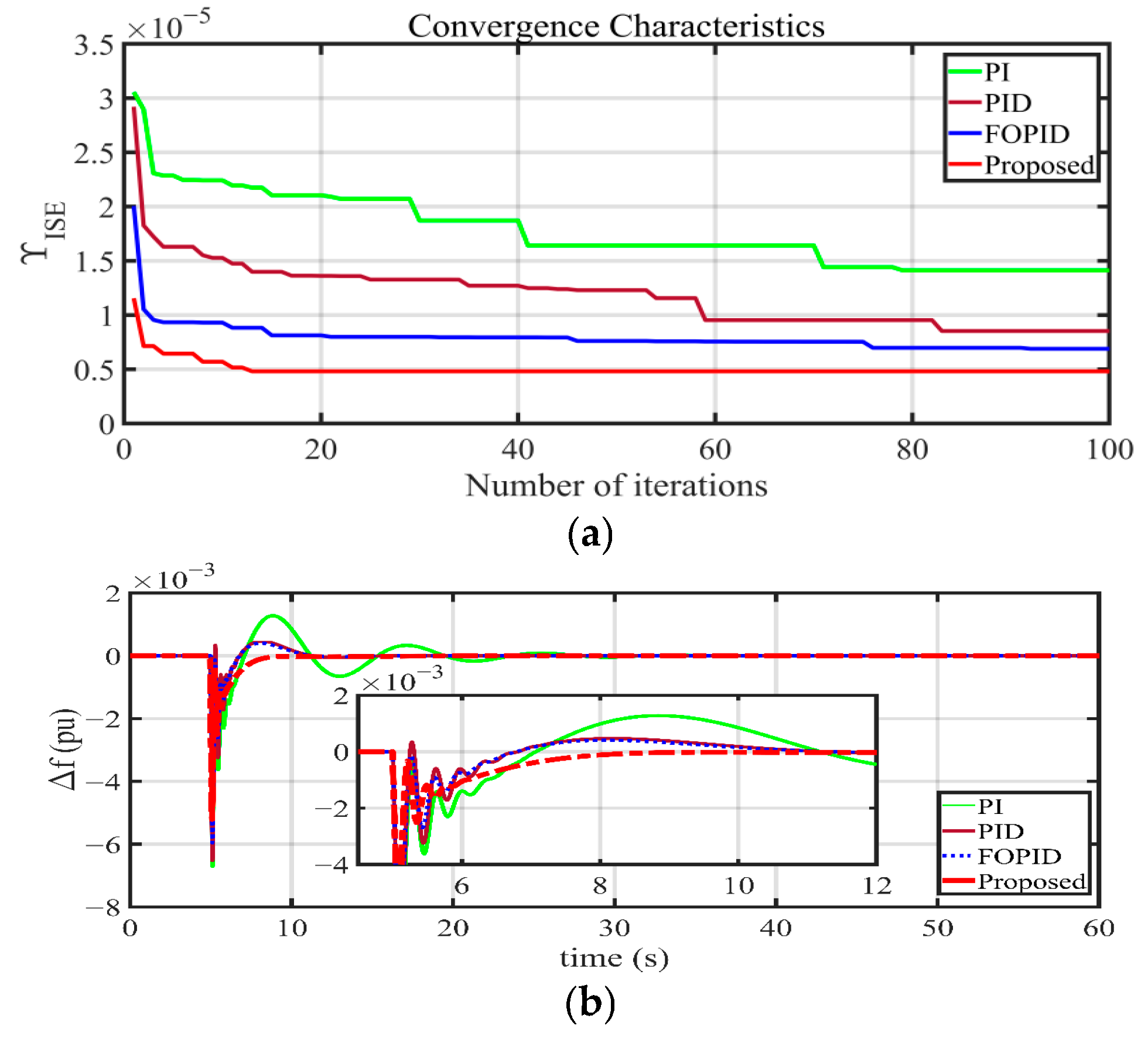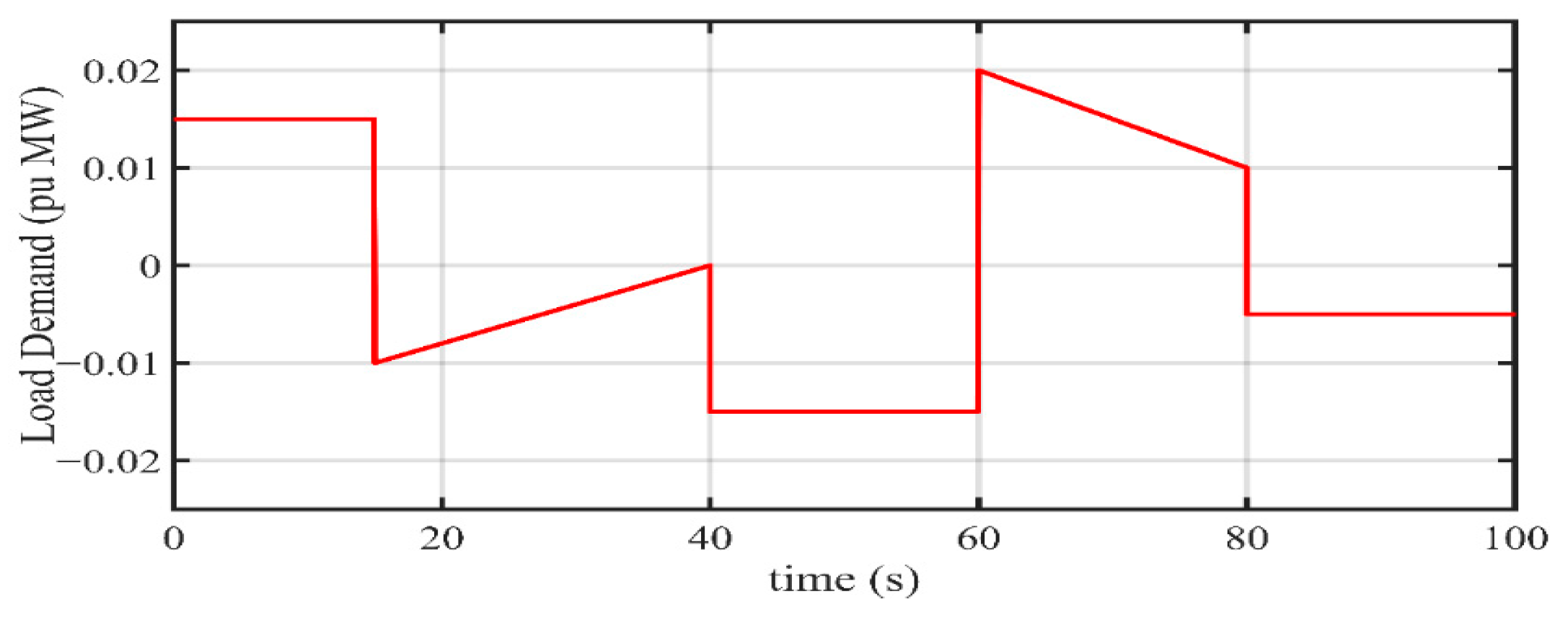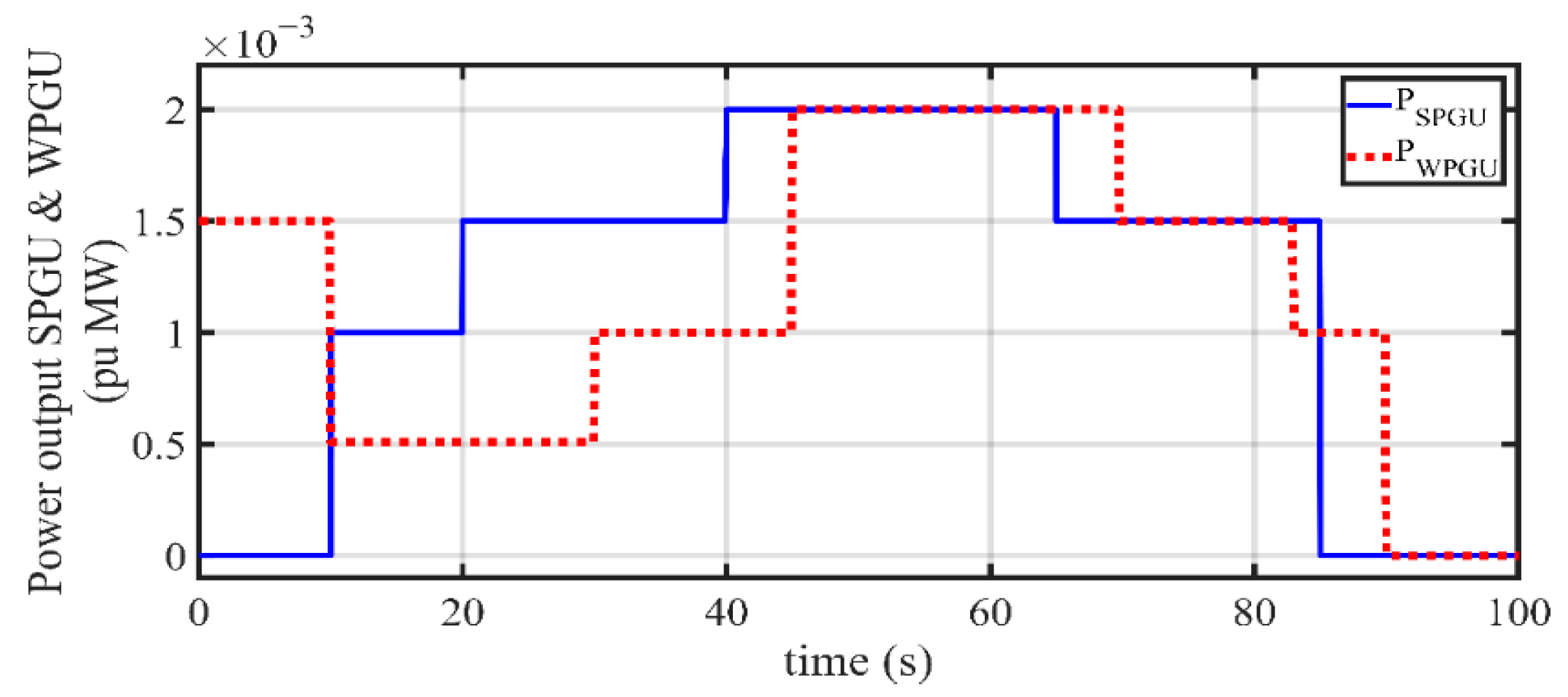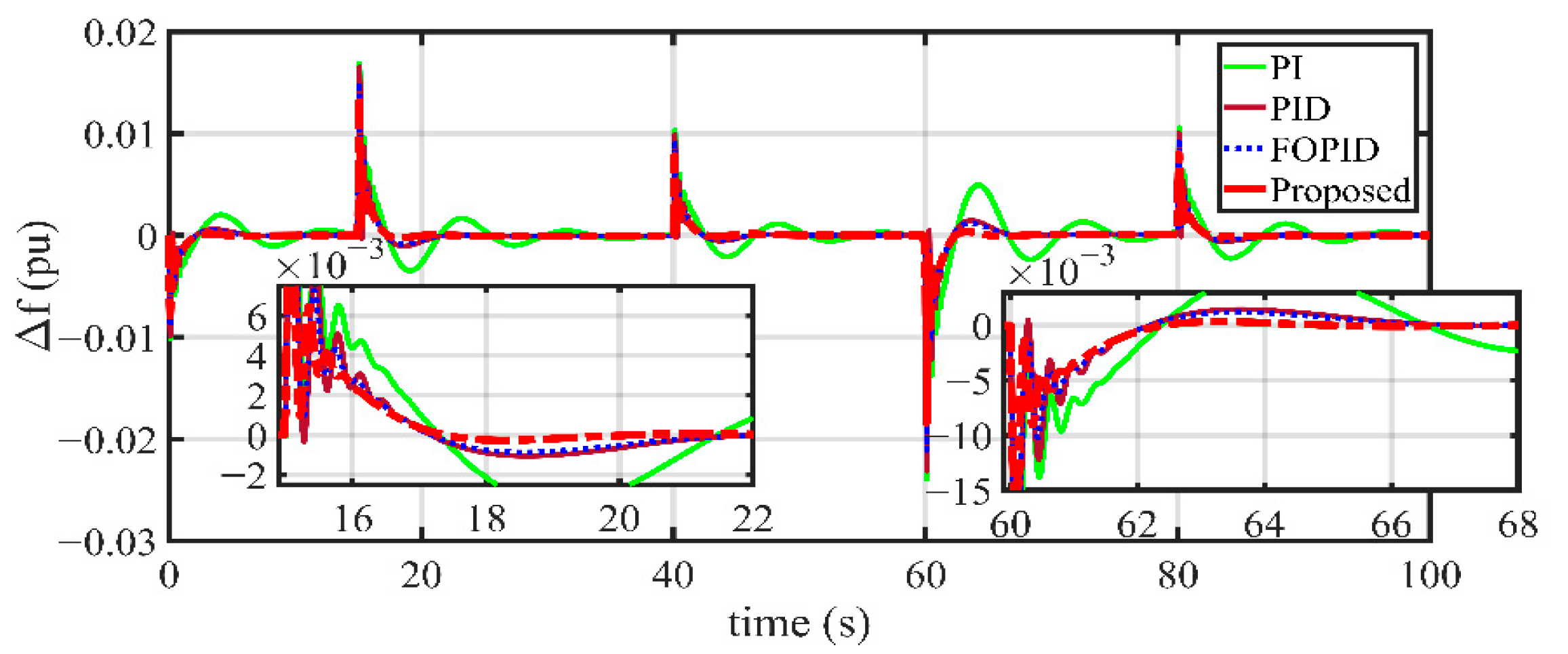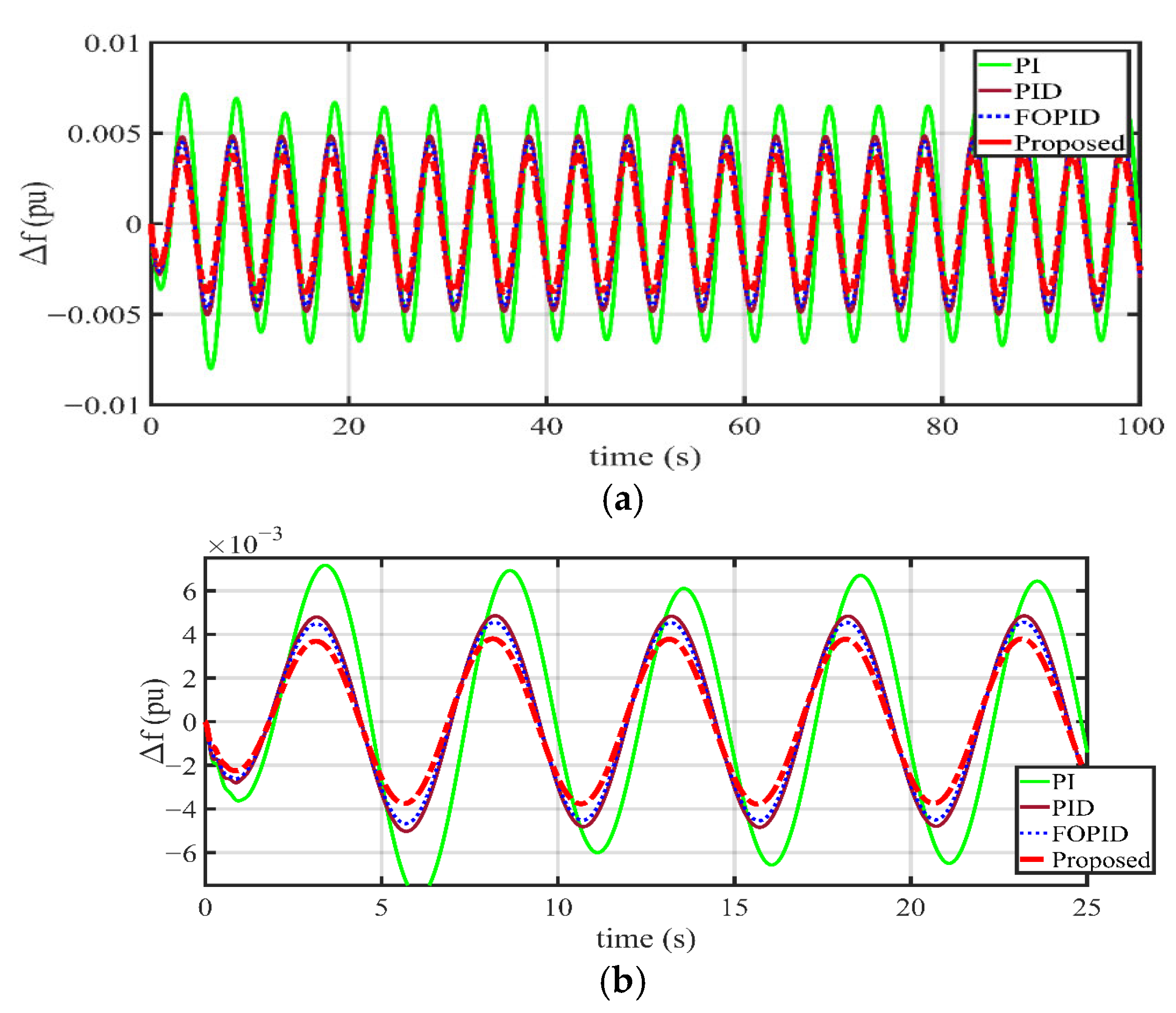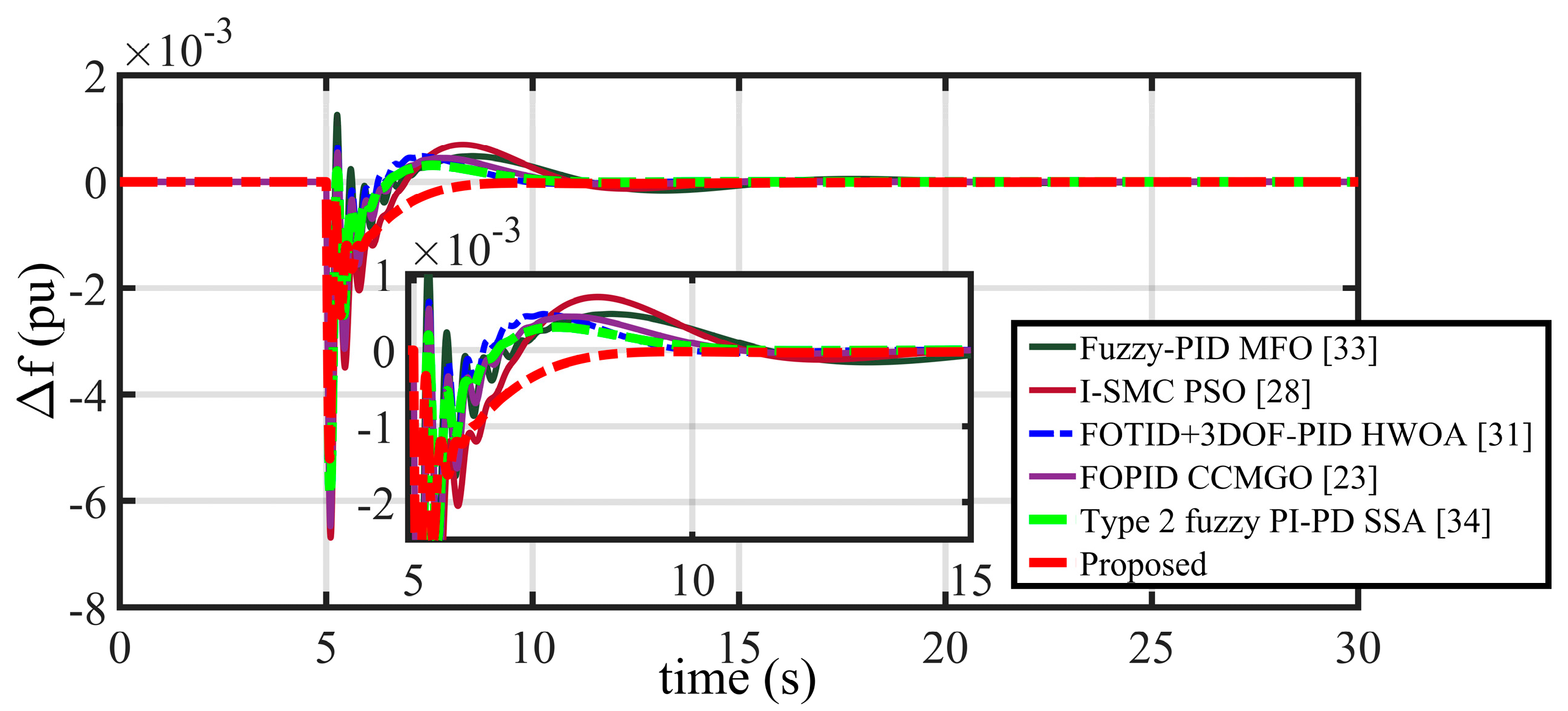1. Introduction
Modern power systems utilise numerous renewable-energy-based power producers (REPPs) to satisfy the ever-increasing power demand. In earlier situations, consumers had to be completely dependent on traditional power producers (TPPs), such as thermal-power-generating units (TPGUs) and hydro-power-generating units (HPGUs). However, among these power resources, the maximum power was produced from TPGUs, utilising harmful fossil fuel. This resulted in undesired environmental degradation and enormous emissions of greenhouse gases. In order to deal with the abovementioned concerns, currently, non-traditional power producers (NTPPs) like solar-power-generating units (SPGUs), wind-power-generating units (WPGUs), tidal energy (TE), and geothermal energy (GTE) are utilised abundantly. Further, these NTPPs are widely operated either with TPPs in grid-connected mode or operated autonomously in an islanded mode microgrid operation [
1,
2]. However, it is observed that most NTPPs depend on environmental conditions, and their generated output power is intermittent in nature. This power intermittency is responsible for causing a mismatch between the load-demanded power and the generated power available from NTPPs. Further, it is also noticed that the mismatch of power results in sustained frequency oscillations in the respective power systems. This frequency oscillation appears as a vulnerability when the system is operated in islanded conditions [
3,
4,
5]. Therefore, during islanded mode operation, diesel generator systems (DGSs) and energy storage units (ESUs) are widely utilised to enhance the power quality by regulating an adequate power–frequency balance. Extensive research work reveals that islanded microgrid operations are very effective in remote areas or regions where there are geographical limitations and regions that traditional power systems are unable to reach. Further, in these types of microgrid scenarios, the diverse mixing of different power-generating units (PGUs) can be observed. Therefore, special attention must be provided to ensuring a proper equilibrium between the power and frequency of the system, ensuring optimal automatic generation control (AGC) operation [
6].
Over the years, numerous research works have been conducted addressing power–frequency synchronism (i.e., AGC) in different power system configurations. It should be noted that mostly, these investigations were performed considering interconnected power system scenarios, including TPPs and NTPPs and mixing both power-generating units [
7,
8,
9,
10,
11]. Compared to this, less attention has been given to research that address AGC issues under the islanded microgrid scenario. Therefore, a wide scope of research opportunities still exists considering this type of power system configuration. Practically, REPPs, mainly NTPPs, are widely utilised in islanded power system scenarios. On the other hand, among diverse NTPPs, SPGUs and WPGUs are extensively employed in islanded power system conditions. Furthermore, it should be noted that their participation is fully dependent on environmental conditions, and the output power from these power producers is intermittent in nature. Apart from SPGUs and WPGUs, aqua electrolyser (AE)-based fuel cell units (FCUs) have also been suggested by some researchers as PGUs in an islanded power system scenario [
12,
13]. In these circumstances, it should be noted that SPGUs and WPGUs do not take part in primary frequency control (PFC) or secondary frequency control (SFC) operations [
14,
15]. Therefore, in an islanded microgrid scenario, to assure stable and secure AGC operations, some components are essential to assist in PFC and SFC operations. Accordingly, it is observed that in many cases, small TPGUs, diesel engine generating units (DGUs), and microturbine units (MTUs) have been incorporated to perform the required PFC and SFC operations [
16,
17,
18]. In addition, ESUs play a crucial role in the proper power management under an islanded microgrid scenario. When extra power is available from SPGUs and WPGUs, the ESUs store energy, and they dispatch this energy when there is sudden load demand. Therefore, the ESUs play an important role in proper, stable, and secure power–frequency management [
19,
20,
21]. Numerous ESUs like flywheel ESUs (FESUs), battery ESUs (BESUs), ultra capacitors (UCs), and redox-flow batteries (RFBs) are already utilised to address power–frequency synchronisation issues [
22,
23]. Further, the extensive integration of NTPPs in the power network often reduces the overall inertia constant, resulting in a power system stability problem. In such systems, often ESUs are integrated to accomplish the required virtual inertia control (VIC) operation [
17,
24]. Therefore, it can be stated that numerous PGUs have been introduced to date to achieve stable and secure islanded microgrid functioning. The contribution of a suitable controller is indispensable in NTPP-based power systems to achieve the desired performance. In this regard, a detailed discussion is presented considering numerous control schemes in the following manner.
In the case of practical scenarios, a suitable controller is essential to ensure adequate power–frequency synchronisation. Over the years, numerous control schemes have been adopted to address the AGC operation associated with different power system scenarios. Some authors have proposed control techniques based on conventional PID controllers and fractional order PID controllers for solving the frequency regulation problem under load disturbance conditions. The conventional control schemes from the literature can be noted as conventional linear quadratic gaussian (LQG) and modified LQG with linear quadratic integral (LQI) control schemes [
16], centralised proportional integral derivative (PID) controller [
25], multistage PID controller [
26], fractional order PID (FOPID) controller [
23,
27], and integral based sliding mode control (I-SMC) [
28]. Recently many authors combined fuzzy logic with conventional control schemes and proposed techniques for regulating frequency deviation problems of AGC operation. They can be addressed as follows: fractional order fuzzy pre-compensated PDPI (FO-FPPDPI) controller [
29], fuzzy PIDF (1 + PI), PIDF and fuzzy-PID controllers [
30], cascade fractional order hybrid controller combining FOTID and 3DOF-PID [
31], disturbance-observer-based controller (DOBC) [
32], and fuzzy-PID controller [
33] and cascade double-input interval type 2 fuzzy logic controller with PI–PD controller [
34]. In addition to the application of numerous control schemes, the model predictive control [MPC] scheme is also utilised to address frequency regulation issues [
22,
35]. Regarding the same, the implementation of artificial intelligence (AI)-based control schemes is also becoming increasingly popular among researchers [
36,
37]. Recently, for tuning the controller gain parameters, most of the authors used various metaheuristic optimisation techniques. Some of the popular techniques are the cheetah optimiser (CO) [
13], improved centripetal force-gravity search algorithm (CF-GSA) [
14], improved sine cosine algorithm (i-SCA) [
20], squirrel search algorithm (SSA) [
22], chaotic chimp-mountain gazelle optimiser (CCMGO) [
23], quasi-oppositional harmony search (QOHS) algorithm [
25], moth-flame optimisation (MFO) [
26,
33], teaching learning based optimisation (TLBO) [
27], particle swarm optimisation (PSO) [
28], multi-objective salp swarm algorithm (MSSA) [
29], hybrid whale optimisation algorithm (HWOA) [
31], salp swarm algorithm (SSA) [
34], genetic algorithm (GA) [
35], and differential evolution (DE) [
38] algorithm. The aforementioned controllers are predominantly designed for specific power system objectives. Therefore, the impacts of diverse operating conditions on system performance are insufficiently addressed. Considering the ongoing moderations and structural modifications, the designing of fast, precise, and dynamic controllers remains an indispensable necessity. In order to address different computational and designing bottlenecks, the (PIDA) controller performs extremely well. Hence, the performance of the PIDA controller is evaluated in this research work.
So far, an exhaustive literature review has been presented considering various aspects of AGC in islanded microgrid scenarios. Additionally, a detailed discussion regarding various suggested control schemes is presented to accomplish seamless power–frequency balance. Although several controller applications with the implementation of different optimisation techniques are presented in various research works such as [
26,
27,
32], there is still a scope left to introduce an effective controller that is flexible, simple, and very easy to use. Additionally, fast convergence and superior responses compared to other available optimisation techniques are the reasons behind selecting a proper metaheuristic technique. Therefore, in the present work, a Fick’s law optimisation (FLO)-based PIDA controller is proposed for efficient operation of AGC with minimum frequency fluctuations under the uncertain operating conditions of an islanded microgrid scenario. Numerous simulation test scenarios are presented and based on the obtained results, and the superiority of the adopted control scheme is established in terms of precise frequency regulation. The simulation results are shown to demonstrate the effectiveness of the proposed control scheme. Considering the critical explorations as well as analysing the bottlenecks, the point-wise contributions of the paper are as follows:
Implementation of a novel method: In this paper, a recently proposed optimisation technique is adopted in the presence of a modified PID controller. Therefore, based on the earlier discussion, the Fick’s law optimisation (FLO)-algorithm-based PIDA controller is proposed for the SFC operation application in an islanded microgrid scenario. Compared to the fractional order-based and the fuzzy logic-based control schemes, the PIDA controller is very simple and easy to implement for practical applications. Based on the detailed literature review and the best of the authors knowledge, the application of the FLO-algorithm-tuned PIDA controller is adopted for the first time in this islanded microgrid scenario.
Innovative initialisation process: Generally, in a metaheuristic technique, the initialisation process is performed randomly. However, in this research work, the gain parameters of the PIDA controller are initialised using the stability range of a pole-zero plot analysis of the controller gain parameters for generating the initial population for the metaheuristic technique instead of choosing them randomly.
Selection of effective control scheme: In the last few decades, it has been observed that the PID control scheme has gained extreme popularity among research engineers and industrialists due to its simplicity and versatility. However, considering the evolving power system scenario with frequent NTPP integration, the PIDA controller is proposed in this research work. The additional acceleration term in the PIDA controller will be helpful to achieve a faster response, better disturbance rejection capability, proper damping, and stability of the frequency of oscillations and to enhance accuracy. Practically, the PIDA controller is a modified version of a simple PID controller with much improved dynamics. Accordingly, a critical exploration is carried out in this work considering the frequency regulation issue in the presence of the PIDA controller.
Detailed performance analysis: Additionally, detailed analytical studies are performed considering numerous simulation studies to replicate a realistic islanded microgrid scenario. In this regard, uncertainty and randomness associated with power generation from SPGUs, WPGUs, and various variations in load demand are considered. In order to evaluate the efficacy of the proposed control scheme, a comparative analysis with the latest research works is presented.
Validation of the proposed configuration: Furthermore, the performance analysis of the proposed control scheme is carried out on a standard 33-bus radial distribution network. This performance analysis is required to understand the system behaviour under a standard power system network to establish appropriate functioning of the proposed control scheme under the chosen islanded microgrid scenario.
The rest of the manuscript is structured as follows:
Section 2 presents the detailing of the materials and methods utilized in this research work. Further, the result analysis is discussed in
Section 3, and the concluding remarks are furnished in
Section 4.



